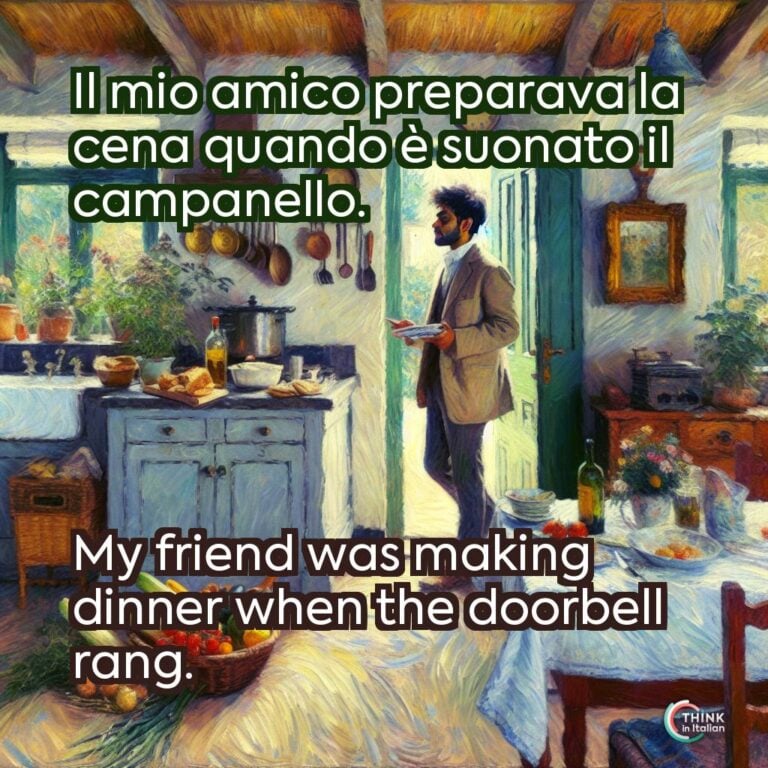Past Tenses in Italian
In Italian, you can use three main types of past tenses to talk about the past: passato prossimo (present perfect), imperfetto (imperfect), and passato remoto (past simple).
Passato prossimo is used to express past finished events and actions. It is composed of the auxiliary verb “to have” or “to be“ and the past participle of the main verb.
Imperfetto is used to express a habit or a continued and prolonged action in the past. It can conceptually be translated with “used to” and is chosen to talk about events that happened at some point in the past, without saying exactly when.
Finally, passato remoto is mainly used in Tuscany and areas in the south of Italy to talk about events that happened long time ago in the past. You can easily survive in Italy without using passato remoto, yet I think it is important to know its existence and conjugation.
What is relevant for this article is the fact that, on the one hand, imperfetto and passato prossimo are often confused by English native speakers because this distinction does not exist in English. On the other hand, these two past tenses can be used together in the same sentence.
So, let me explain the main differences, how they are used, and when.
Passato Prossimo vs Imperfetto
When to use Passato Prossimo in Italian
In Italian, we use passato prossimo to:
- Talk about past events or actions that happened a while ago but still have an effect on the present.
- Talk about past events or actions that happened during a limited time, meaning that they started and ended at a specific point in time.
Let’s take a look at some examples:
Ho parlato con Maya ieri.
I spoke to Maya yesterday.
Siamo andati a trovare Matteo la settimana scorsa.
We visited Matteo last week.
Remember that when you use passato prossimo you must choose the right auxiliary verb (essere or avere) and that, when you use essere, the past participle must agree in gender and number with the subject of the sentence.
Also, since passato prossimo is used to talk about actions that happened in a specific moment of the past, there are several expressions of time that can be combined with it, like:
- stamattina (this morning)
- ieri (yesterday)
- l’altro giorno (the other day)
- la settimana/il mese/l’anno scorso/scorsa (last week/month/year)
- appena (just)
- amount of time fa (amount of time ago)
When to use Imperfetto in Italian
We use imperfetto to:
- Talk about past events that started and ended during an undetermined and presumably long period of time.
- Describe situations, people, events in the past.
- Talk about past habits or habitual actions occurring regularly in the past.
Have a look at the following examples:
La mia prima bicicletta era bianca.
My first bike was white.
Da piccolo, avevo i capelli castani.
When I was little, I had brown hair.
As I mentioned before, a good trick to avoid confusing these two tenses is to translate imperfetto with “used to”, as in “when I was little, I used to have brown hair”.
And here is a list of some time expressions commonly used with it:
- sempre (always)
- mai (never)
- spesso (often)
- tutti i giorni (every day)
- da + period of time (when I was…)
- a volte (ometimes)
- ogni tanto (once in a while)
When to use Passato Prossimo and Imperfetto Together
We use passato prossimo and imperfetto together to describe two past actions happening at the same time in the past.
Specifically, we use imperfetto to describe the background action, that is, the event that was occurring when something else interrupted it, and we use passato prossimo for the interrupting action.
For this type of structure, we introduce imperfetto with mentre (while).
Mentre andavo in ufficio, ho incontrato Marco.
While I was going to the office, I met Marco.
Otherwise, we can also introduce passato prossimo with quando (when).
Quando ho incontrato Marco, andavo in ufficio.
When I met Marco, I was going to the office.
Below I wrote some more examples of these two tenses:
Studiavamo quando improvvisamente ha squillato il telefono.
We were studying when suddenly the telephone rang.
Mentre camminavolungo il fiume, ho sentito un rumore improvviso.
I was walking along the river when I heard a sudden noise.
Quando David viveva in Italia, ha visitato sia Roma sia Firenze.
During the time David lived in Italy, he visited both Rome and Florence.
Notice that, here, quando is used with the meaning of mentre, therefore it introduces imperfetto.
Mentre Luca scriveva una e-mail, il computer ha smesso di funzionare.
While Luca was writing an e-mail, the computer stopped working.
Ready to Talk About Past Actions
Understanding these two past tenses is not easy, I know! But do not worry, the more you practice, the more you understand. This is because, in English, we use the past simple for almost all past events, and there is no distinction between different past tenses.
What most of my students find useful, is to look at the expressions of time: if you know when something happened, then it’s likely passato prossimo, and if the time when an event occurred is not specified, then it’s probably imperfetto.
Practice the use of these two verb tenses, and I promise you will speak Italian sooner than you think.




